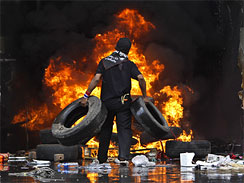Bangkok became a flaming battleground Wednesday as an army assault forced anti-government protest leaders to surrender, enraging followers who shot grenades and set fire to landmark buildings, cloaking the skyline in black smoke.
Using live ammunition, troops dispersed thousands of Red Shirt protesters who had been camped in the capital’s premier shopping and residential district for weeks. Five protesters and an Italian news photographer were killed in the ensuing gunbattles and about 60 wounded.
After Red Shirt leaders gave themselves up to police, rioters set fires at the Stock Exchange, several banks, the headquarters of the Metropolitan Electricity Authority, the Central World, one of Asia’s biggest shopping malls, and cinema that burned to ground. There were reports of looting.
Firefighters retreated after protesters shot guns at them, and thick smoke drifted across the sky of this city of 10 million people.
Sporadic clashes between troops and protesters continued in the night at the site of former protest camp.
The chaos in Bangkok in the wake of the two-month protest will deepen the severe impact dealt to the economy and tourism industry of Thailand, a key U.S. ally and long considered one of the more stable countries in Southeast Asia. The Red Shirts had demanded the ouster of Prime Minister Abhisit Vejjajiva’s government, the dissolution of Parliament and new elections.
A 10-hour curfew came into force in Bangkok and 18 other provinces at 8 p.m., and the government said army operations would continue through the night in the Thai capital.
It is the first time that Bangkok has been put under curfew since 1992, when the army killed dozens of pro-democracy demonstrators seeking the ouster of a military-backed government.
“Tonight is going to be another worrisome night,” government spokesman Panitan Wattanayagorn said.
The government also imposed a partial media blackout on local TV stations, saying all of them will have to air government-prepared bulletins.
“They might be able to show their regular news programs. But we are concerned about their live broadcasts from the scenes,” Panitan said. “There will be more (government) programs … to be shown simultaneously by all stations,” he said.
Protesters had already turned their rage on the local media, which they have accused of pro-government coverage. They attacked the offices of state-run Channel 3, setting fire to cars outside and puncturing water pipes that flooded the building.
“At Channel 3 need urgent help from police, soldiers!!!” tweeted news anchor Patcharasri Benjamasa. “News cars were smashed and they are about to invade the building.”
Hours later its building was on fire. Its executives were evacuated by helicopter and police rescued other staff. The English-language Bangkok Post newspaper evacuated its staff after threats from the Red Shirts. A large office building down the street from the Post was set afire.
Thailand’s stock exchange would be closed for the rest of the week after rioters set the building’s ground floor on fire, its president, Patareeya Benjapolchai, told The Associated Press.
The exchange, where about $600 million of shares change hands each day, may reopen on Monday, she said. The central bank, meanwhile, said all financial institutions in Bangkok including commercial banks would be shut Thursday and Friday.
Unrest also spread to the rural northeast of the country, where Red Shirts, who claim Abhisit’s government is elitist and oblivious to their plight, retain strong support.
Local media reported protesters set fire to government offices in the city of Udon Thani and vandalized a city hall in Khon Kaen. Udon Thani’s governor asked the military to intervene. TV images also showed troops retreating after being attacked by mobs in Ubon Ratchathani.
Cabinet minister Satit Vongnongteay described the chaos as anticipated “aftershocks.”
“There are violent-prone protesters who remain angry,” Satit told a news conference.
At least 74 people have been killed and nearly 1,800 injured since the Red Shirts descended on Bangkok in mid-March to press their demands. Of those, at least 45 people, most of them civilians, have died in clashes that started last Thursday after the army tried to blockade the protesters who had camped in the 1-square-mile (3-square-kilometer) Rajprasong district.
The final crackdown began soon after dawn Wednesday, as hundreds of troops armed with M-16s converged on Rajprasong, where high-end malls and hotels have been shuttered for weeks.
Armored vehicles crashed through barricades of piled tires and bamboo stakes, then soldiers gradually moved toward the protesters’ hub, opening fire and drawing return fire from militant Red Shirts, Associated Press journalists saw.
Bullets flew overhead and several grenades exploded near the soldiers, forcing them to pull back and take cover briefly before pushing forward. A Canadian freelance reporter was injured by grenade shrapnel. Two other journalists were wounded earlier, one Dutch man and an American documentary filmmaker. An Italian photographer was killed.
With no hope of resisting the military’s advance, seven top Red Shirt leaders turned themselves in on Wednesday afternoon, saying they cannot see their supporters — women and children among them — being killed anymore.
“Brothers and sisters, I’m sorry I cannot see you off the way I welcomed you all when you arrived here. But please be assured that our hearts will always be with you,” Nattawut Saikua, a key leader, said as he was being arrested.
“Please return home,” he said.
By mid-afternoon, the army announced it had gained control of the protest zone and the operations had ended — nine hours after troops launched the pre-dawn assault — although sporadic clashes with rioters continued into the night.
